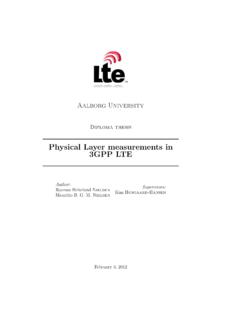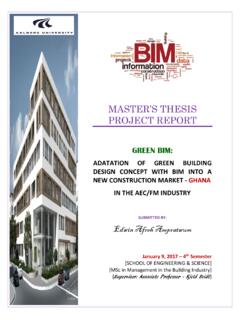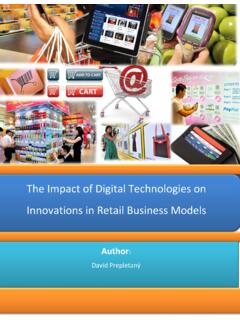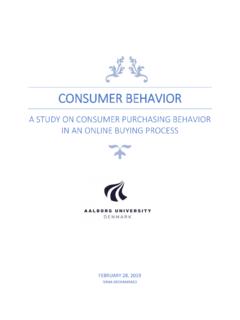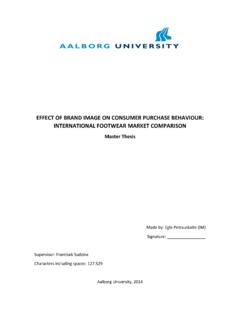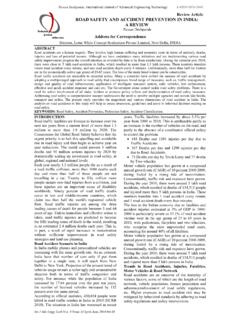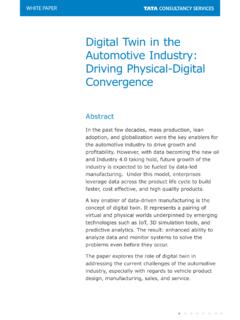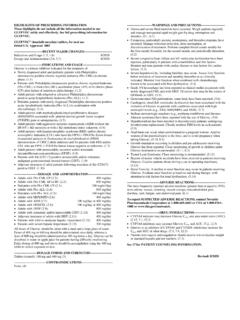Transcription of Title: The development of autonomous vehicles
1 Semester: 4th Title: The development of autonomous vehicles Project Period: Autumn 2016 Spring 2017 Semester Theme: Master Thesis Supervisor: Anders Henten Author: Filip Hucko Group: ICTE34 BD L3 Pages: 115 Finished: Abstract: The thesis addresses development of autonomous vehicles and their future implications in a sharing economy. Right now, autonomous vehicles are still in a research and development phase, but numerous of powerful stakeholders are already forming partnerships in order to strengthen their position on future transportation markets. Based on theories of innovation and dominant design, the thesis will analyze the development of autonomous vehicles with a focus on the interplay between technology developers, ride-hailing service providers, and automakers.
2 This research will examine essential pillars of autonomous technology that are the basic foundation of the autonomous driving intelligence. Once the connection between autonomous vehicles and sharing economy is explained, the research will analyze the market and governance formation. Study further emphasize on which ride-haling service providers have currently the highest chance to acquire a dominant design and become a market leader in providing autonomous on-demand transportation. Aalborg University Copenhagen Meyers V nge 15 2450 K benhavn SV Semester Coordinator: Henning Olesen Secretary: Maiken Keller 1 Acknowledgements First, I would like to thank my supervisor Anders Henten, who supported, guided and gave me a valuable lessons during the process of writing the thesis.
3 Special credit belongs to my parents who mentally supported me to through my studies. Also I would like to salute to all of the people who are involved in a development of autonomous vehicles and related technology for those cars. They are working towards more sustainable and secure transportation for our future generations to come. Key Words Autonomy, autonomous , Self-driving, Transportation, Ride-hailing, Sharing Economy,Dominant Design, Business Models 2 Table of Content 1. Introduction .. 6 Benefits of autonomous vehicles .. 7 Potential problems of autonomous vehicles .
4 8 Motivation .. 8 2. Methodology .. 10 Research Design and Research Objectives .. 10 Delimitation .. 11 Literature review and the approach to theory development .. 11 Topics & Tools .. 14 .. 16 Definitions .. 16 Stages of autonomous driving .. 17 autonomous driving level classifications: .. 17 Pillars of autonomous driving .. 24 Perception - Sensing .. 24 Mapping .. 31 Driving Intelligence Policy .. 32 The role of ICT in autonomy .. 35 Connection between autonomous cars and Sharing economy .. 37 4. Theory .. 42 Theory of Dominant Design .. 42 Theory of Innovation .. 47 Diffusion of Innovation.
5 48 Drivers of Innovation - Market adoption .. 49 Business Model .. 51 Definition .. 51 3 Dominant Business model design and Customer Bonding .. 53 Sharing economy .. 56 Capital .. 56 Timing .. 56 Internet-based platforms .. 57 .. 58 Dominant design .. 58 Dominat product design of a AVs .. 58 Dominant Business model design .. 60 Sharing Economy .. 62 The role of OEM and Tech companies in stake .. 64 Scenarios .. 67 Case studies .. 70 Simulation .. 70 Current Leaders in the development of autonomous vehicles .. 77 Ford .. 80 GM .. 81 Google Waymo .. 82 Criteria Definition .. 82 Strategy.
6 83 Key players development .. 84 Uber .. 84 Lyft .. 91 Tesla .. 95 6. Discussion .. 101 7. Conclusion .. 109 Reference list .. 110 4 List of abbreviations AT autonomous Taxi AV autonomous vehicle B2B Business to Business BM Business Model BMC Business Model Canvas C2C Customer to Customer CDV Conventional Driven vehicles EV Electric vehicle FIFO First in First out GPS Global Positioning System HW Hardware IEEE Institute of Electrical and Electronics Engineers IoT Internet of Things IPR Intellectual Property Rights LiDAR Light Detection and Ranging NHTSA National Highway Traffic Safety Administration NLOS Non-line-of-sight propagation OEM Original Equipment Manufacturer R&D Research and development SW Software TaSS Transportation as a
7 Service V2I vehicle to infrastructure V2p vehicle to Pedestrian V2V vehicle to vehicle V2X vehicle to X 5 List of Figures: Figure : The connection between Lit. study and Emp. Study 11 Figure : Overview of the Empirical Study 12 Figure : Structure of the study 12 Figure : 5 levels of autonomy by SEA 20 Figure : Radar Performance 23 Figure : Radar Performance Figure :. Ultrasonic radar performance 25 Figure : LiDAR sensing of surroundings 26 Figure : LiDAR performance 27 Figure ; Tesla Self Driving Car Demo Video Analyzed 29 Figure : How cars learn 31 Figure : A-U model of product and process innovation 42 Figure : Roger s diffusion of innovation curve 46 Figure : Four stages in the bonding continuum 52 Figure : Industry BM shifts Figure : The Four Stages of Mobility 60 Figure Old and new model of stakeholders in automotive industry 62 Figure : AV mobility value chain 63 Figure : End game scenarios based on ownership 66 Figure : Hourly demand for AT trips during the day 68 Figure : Locations of AT trip origins 68 Figure.
8 vehicle operations and open request over the whole day for different AT fleet sizes 71 Figure : Passenger wait times for each hour 73 Figure : Average operation mode split for each hour the 73 Figure : vehicles categorized by the hourly share of idle time 74 Figure : Empty drive ratios for each hour 74 Figure The Navigant Research Leaderboard Grid 76 Figure : Criteria performance Uber 87 Figure : Criteria performance Lyft 92 Figure : Criteria performance Tesla 96 Figure : Main Stakeholder relationships 101 List of Tables: Table autonomous vehicle Implementation Stages 21 Table: Criteria evaluation 102 6 1.
9 Introduction Opening The invention of an automobile transportation shaped our society in a way how we commute, build our cities and infrastructure, where we live and how we created a new industry. Automobile mobility provide us with a set of advantages, such as considerable freedom of transportation for those who can afford to own the car and it helps to maintain a sustainable economic growth. Yet, there are many side effects, that make the current vehicles unsustainable, if we take into account their safety, energy-related environmental impacts, traffic congestions, time spent by their operation and land use.
10 [1][2] Today s Cars Are Parked 95% of the Time. Paul Barter[3] Considering that cars are used only 5 percent of the time, and they spent the rest of the time parked, makes personal vehicle ownership unsustainable. Over the decades since the first motor vehicle was introduced by Karl Benz, car manufacturers took a steady incremental approach in technology development of cars. Following the recent trends in an automotive research and development , there is a clear sign that many organizations are racing towards fully autonomous vehicles with technology that will get rid of drivers as the one who controls the cars.
